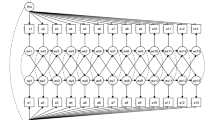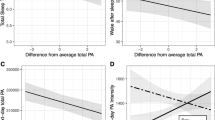Abstract
Background
Although sleep is often associated with waking health behaviors (WHB) such as alcohol consumption, caffeine use, smoking, and exercise, the causal direction of these relationships is unclear.
Purpose
The present study used time series data to examine the temporal dynamics of WHB and sleep characteristics in participants of the Study of Women's Health Across the Nation Sleep Study.
Methods
Three hundred three women completed daily assessments of WHB and wore wrist actigraphs to measure sleep characteristics for the duration of the study (mean = 29.42 days, SD = 6.71).
Results
Vector autoregressive modeling revealed that weekly patterns of sleep and WHB best predicted subsequent sleep and WHB suggesting that the associations between WHB and sleep persist beyond their immediate influence. Some WHB predicted some subsequent sleep characteristics, but sleep did not predict subsequent WHB.
Conclusions
These novel findings provide insight into the temporal dynamics of 24-h behaviors and encourage consideration of both sleep and WHB in health promotion and behavior change efforts.

Similar content being viewed by others
References
World Health Organization. Health topics: Chronic diseases. Accessible at http://www.who.int/topics/chronic_diseases/en/. Accessibility verified November 12, 2012.
Khaw K, Wareham N, Bingham S, Welch A, Luben R, Day N. Combined impact of health behaviors and mortality in men and women: The EPIC-Norfolk prospective population study. PLoS Med. 2008; 5: e12.
Mokdad AH, Stroup DF, Giles WH. Public health surveillance for behavioral risk factors in a changing environment: Recommendations from the Behavioral Risk Factor Surveillance team. MMWR Weekly. 2003; 52: 1-12.
Cappuccio FP, D'Elia L, Strazzullo P, Miller MA. Sleep duration and all-cause mortality: A systematic review and meta-analysis of prospective studies. Sleep. 2010; 33: 585-592.
Zaharna M, Guilleminault C. Sleep, noise and health: Review. Noise & Health. 2010; 12: 64-69.
Phillips BA, Danner FJ. Cigarette smoking and sleep disturbance. Arch Intern Med. 1995; 155: 734-737.
Roehrs T, Roth T. Sleep, sleepiness, sleep disorders and alcohol use and abuse. Sleep Med Rev. 2001; 5: 287-297.
Roehrs T, Roth T. Caffeine: Sleep and daytime sleepiness. Sleep Med Rev. 2008; 12: 153-162.
Schoenborn CA, Adams PF. Sleep duration as a correlate of smoking, alcohol use, leisure time physical inactivity, and obesity among adults: United States, 2004–2006. NCHS Health E-Stats. 2008. Available at http://www.cdc.gov/nchs/data/hestat/sleep04-06/sleep04-06.pdf. Availability verified November 12, 2012
Strine TW, Chapman DP. Associations of frequent sleep insufficiency with health-related quality of life and health behaviors. Sleep Med. 2005; 6: 23-27.
Youngstedt SD, Kline CE. Epidemiology of exercise and sleep. Sleep Biol Rythms. 2006; 4: 215-221.
Zhang L, Samet J, Caffo B, Punjabi NM. Cigarette smoking and nocturnal sleep architecture. Am J Epidemiol. 2006; 164: 529-537.
Feige B, Gann H, Brueck R, et al. Effects of alcohol on polysomnographically recorded sleep in healthy subjects. Alcohol Clin Exp Res. 2006; 30: 1527-1537.
Santos RVT, Tufik S, DeMello MT. Exercise, sleep and cytokines: Is there a relation? Sleep Med Rev. 2007; 11: 231-239.
Dworak M, Diel P, Voss S, Hollmann W, Strüder HK. Intense exercise increases adenosine concentrations in the rat brain: Implications for homeostatic sleep drive. Neurosci. 2007; 150: 789-795.
Buman MP, King AC. Exercise as a treatment to enhance sleep. Am J Lifestyle Med. 2010; 4: 500-515.
Banks S, Dinges DF. Behavioral and physiological consequences of sleep restriction. J Clin Sleep Med. 2007; 3: 519-528.
Walker MP. The role of sleep in cognition and emotion. Ann NY Acad Sci. 2007; 1156: 168-197.
Penev PD. Update on energy homeostasis and insufficient sleep. J Clin Endocrinol Metab. 2012; 97: 1792-1801.
Holahan CJ, Moos RH, Holahan CK, Cronkite RC, Randall PK. Drinking to cope, emotional distress and alcohol use and abuse: A ten-year model. J Stud Alcohol Drugs. 2001; 62: 190-198.
Lang AR, Patrick CJ, Stritzke WK. Alcohol and emotional response: A multidimensional-multilevel analysis. In: Leonard KE, Blane HT, eds. Psychological theories of drinking and alcoholism. 2nd ed. New York: Guilford Press; 1999: 328-371.
Ancoli-Israel S, Roth T. Characteristics of insomnia in the United States: Results of the 1991 National Sleep Foundation Survey. Sleep. 2000; 22: S347-S353.
Sowers MF, Crawford S, Sternfeld B, et al. SWAN: A multi-center, multi-ethnic, community-based cohort study of women and the menopausal transition. In: Lobo R, Kelsey J, Marcus R, eds. Menopause: Biology and pathobiology. San Diego: Academic; 2000: 175-188.
Rush AJ, Carmody TJ, Arnow B, et al. The 16-item Quick Inventory of Depressive Symptomatoloty (QIDS), clinician rating (QIDS-C), and self-report (QIDS- SR): A psychometric evaluation in patients with chronic major depression. Biol Psychiatry. 2003; 54: 573-583.
Spielberger CD. Manual for the State-Trait Anxiety Inventory (Form Y). Menlo Park, CA: Mind Garden; 1983.
Kushida CA, Chang A, Gadkary C, Guilleminault C, Carrillo O, Dement WC. Comparison of actigraphic, polysomnographic, and subjective assessment of sleep parameters in sleep-disordered patients. Sleep Med. 2001; 2: 389-396.
Ware JJ, Sherbourne CD. The MOS 36-item short-form health survey (SF-36): Conceptual framework and item selection. Med Care. 1992; 30: 473-483.
Gold EB, Sternfeld B, Kelsey JL, et al. The relation of demographic and lifestyle factors to symptoms in a multi-ethnic population of 40–55-year-old women. Am J Epidemiol. 2000; 152: 463-473.
Gold EB, Colvin A, Avis N, et al. Longitudinal analysis of vasomotor symptoms and race/ethnicity across the menopausal transition: Study of Women's Health Across the Nation (SWAN). Am J Public Health. 2006; 96: 1226-1235.
Campbell IG, Bromberger JT, Buysse DJ, et al. Evaluation of the association of menopausal status with delta and beta EEG activity during sleep. Sleep. 2011; 34: 1561-1568.
Utian WH. Psychosocial and socioeconomic burden of vasomotor symptoms in menopause: A comprehensive review. Health Qual Life Outcomes. 2005; 3: 1-10.
Granger CWJ. Testing for causality: A personal viewpoint. J Econ Dyn Control. 1980; 2: 329-352.
Shumway RH, Stoffer DS. Time series analysis and its applications. New York: Springer; 2011.
Hall MH, Matthews KA, Kravitz HM, et al. Race and financial strain are independent correlates of sleep in midlife women: The SWAN Sleep Study. Sleep. 2009; 32: 73-82.
Troxel WM, Buysse DJ, Matthews KA, et al. Marital/cohabitation status and history in relation to sleep in midlife women. Sleep. 2010; 33: 973-981.
Stepanski EJ, Wyatt JK. Use of sleep hygiene in the treatment of insomnia. Sleep Med Rev. 2003; 7: 215-225.
Morgenthaler T, Kramer M, Alessi C, et al. Practice parameters for the psychological and behavioral treatment of insomnia: An update. Sleep. 2006; 29: 1415-1419.
Chen PH, Kuo HY, Chueh KH. Sleep hygiene education: Efficacy on sleep quality in working women. J Nurs Res. 2010; 18: 283-289.
Youngstedt SD, O'Connor PJ, Dishman RK. The effects of acute exercise on sleep: A quantitative synthesis. Sleep. 1997; 20: 203-214.
Kline CE, Sui X, Hall MH, et al. Dose–response effects of exercise training on the subjective sleep quality of postmenopausal women: Exploratory analyses of a randomized controlled trial. BMJ Open. 2012; 2: e001044.
Cohen-Mansfield J, Kivity Y. The relationships among health behaviors in older persons. J Aging Health. 2011; 23: 822-842.
Jung KI, Song CH, Ancoli-Israel S, Barrett-Connor E. Gender differences in nighttime sleep and daytime napping as predictors of mortality in older adults: The Rancho–Bernado Study. Sleep Med. 2012; 14(1): 12-19.
Lindberg E, Janson C, Gislason T, Björnsson E, Hetta J, Boman G. Sleep disturbances in a young adult population: Can gender differences be explained by differences in psychological status? Sleep. 1997; 20: 381-387.
Quindry JC, Yount D, O'Bryant H, Rudisill ME. Exercise engagement is differentially motivated by age-dependent factors. Am J Health Behav. 2011; 35: 334-345.
Scharff DP, Homan S, Kreuter M, Brennan L. Factors associated with physical activity in women across the lifespan: Implications for program development. Women Health. 1999; 29: 115-134.
Substance Abuse and Mental Health Services Administration (SAMHSA). Results from the 2008 National Survey on Drug Use and Health: National Findings. Rockville, MD: Substance Abuse and Mental Health Services Administration, Office of Applied Studies; 2009.
Hale L, Do DP. Racial differences in self-reports of sleep duration in a population based study. Sleep. 2007; 30: 1096-1103.
He X, Baker DW. Differences in leisure-time, household, and work-related physical activity by race, ethnicity, and education. J Gen Intern Med. 2005; 20: 259-266.
Chaput JP, Despres JP, Bouchard C, Tremblay A. The association between short sleep duration and weight gain is dependent on disinhibited eating behavior in adults. Sleep. 2011; 34(10): 1291-1297.
Kravitz HM, Zhoa X, Bromberger JT, et al. Sleep disturbance during the menopausal transition in a multi-ethnic community sample of midlife women. Sleep. 2008; 31: 979-990.
Shaver JLF, Zenk SN. Sleep disturbance in menopause. J Womens Health Gend Based Med. 2000; 9: 109-118.
Ohayon MM, Carskadon MA, Guilleminault C, Vitiello MV. Meta-analysis of quantitative sleep parameters from childhood to old age in healthy individuals: Developing normative sleep values across the lifespan. Sleep. 2004; 27: 1255-1273.
Acknowledgments
The Study of Women's Health Across the Nation (SWAN) has grant support from the National Institutes of Health (NIH), DHHS, through the National Institute on Aging (NIA), the National Institute of Nursing Research (NINR), and the NIH Office of Research on Women's Health (Grants U01NR004061, U01AG012505, U01AG012535, U01AG012531, U01AG012539, U01AG012546, U01AG012553, U01AG012554,and U01AG012495). The SWAN Sleep Study was funded by the NIH (grants AG019360, AG019361, AG019362, and AG019363). Sleep data were processed with the support of RR024153. Grant support for LAI was provided by NIH MH019986 and support for CEK was provided by NIH HL082610. Additional grant support for RTK was provided by National Science Foundation DMS-0805050 and support for SDR was provided by NIH HL 104607. The content of this paper is solely the responsibility of the authors and does not necessarily represent the official views of the NSF, NIA, NINR, ORWH, or the NIH.
Clinical Centers
University of Michigan, Ann Arbor, MI, USA (Siobán Harlow, PI 2011–present; MaryFran Sowers, PI 1994–2011); Massachusetts General Hospital, Boston, MA, USA (Joel Finkelstein, PI 1999–present; Robert Neer, PI 1994–1999); Rush University, Rush University Medical Center, Chicago, IL, USA (Howard Kravitz, PI 2009–present; Lynda Powell, PI 1994–2009); University of California, Davis/Kaiser (Ellen Gold, PI); University of California, Los Angeles, CA, USA (Gail Greendale, PI); Albert Einstein College of Medicine, Bronx, NY, USA (Carol Derby, PI 2011–present; Rachel Wildman, PI 2010–2011; Nanette Santoro, PI 2004–2010); University of Medicine and Dentistry–New Jersey Medical School, Newark, NJ, USA (Gerson Weiss, PI 1994–2004); and the University of Pittsburgh, Pittsburgh, PA, USA (Karen Matthews, PI).
NIH Program Office
National Institute on Aging, Bethesda, MD, USA (Winifred Rossi 2012–present; Sherry Sherman 1994–2012; Marcia Ory 1994–2001) and the National Institute of Nursing Research, Bethesda, MD, USA (program officers).
Central Laboratory
University of Michigan, Ann Arbor, MI, USA (Daniel McConnell (Central Ligand Assay Satellite Services).
Coordinating Center
University of Pittsburgh, Pittsburgh, PA, USA (Maria Mori Brooks, PI 2012–present; Kim Sutton-Tyrrell, PI 2001–2012) and New England Research Institutes, Watertown, MA, USA (Sonja McKinlay, PI 1995–2001).
Steering Committee
Susan Johnson, Current Chair; Chris Gallagher, Former Chair.
We thank the study staff at each site and all the women who participated in SWAN.
Conflicts of Interest
With the exception of DJB, the authors have no conflicts of interest to disclose. Dr. Buysse has served as a paid or unpaid consultant on scientific advisory boards for the following companies: Merck, Philips Respironics, Purdue Pharma and General Sleep Corporation. Dr. Buysse has also spoken at single-sponsored educational meetings for Servier. He has also spoken at a single-sponsored lecture for Astellas. Total fees from each of these sources were less than $10,000 per year.
Author information
Authors and Affiliations
Corresponding author
About this article
Cite this article
Irish, L.A., Kline, C.E., Rothenberger, S.D. et al. A 24-hour Approach to the Study of Health Behaviors: Temporal Relationships Between Waking Health Behaviors and Sleep. ann. behav. med. 47, 189–197 (2014). https://doi.org/10.1007/s12160-013-9533-3
Published:
Issue Date:
DOI: https://doi.org/10.1007/s12160-013-9533-3




